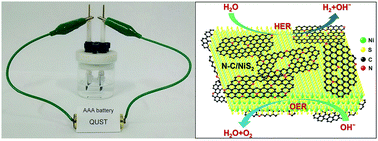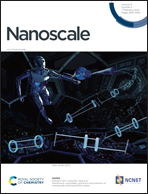Surface/interface engineering N-doped carbon/NiS2 nanosheets for efficient electrocatalytic H2O splitting†
Abstract
A facile and effective method for preparing bifunctional electrocatalysts with enhanced activity and stability is desired for hydrogen and oxygen production. In this paper, ion-liquid-like (ILL) nickel–urea (Ni–U) was designed and applied to prepare 2D N-doped carbon/NiS2 (N–C/NiS2) nanohybrids by a one-step in situ pyrolysis synthesis strategy. The fluidity of ILL Ni–U benefits the interface coupling of the 2D N–C/NiS2 nanohybrid. Due to the synergistic effect between NiS2 and N–carbon with high conductivity, the H2O splitting performance of 2D N–C/NiS2 nanohybrids was significantly enhanced in alkaline media. The corresponding two-electrode cell only needed 1.53 V to undertake 10 mA cm−2 for H2O splitting. Moreover, the resultant 2D N–C/NiS2 nanohybrids exhibited lasting electrochemical endurance with the maintenance of its stability for more than 48 h. The synthetic strategy not only provides a simple and scalable route for constructing 2D hybrid electrocatalysts, but also paves a way to improve the HER/OER activity of sulphides via the surface/interface engineering strategy.


 Please wait while we load your content...
Please wait while we load your content...